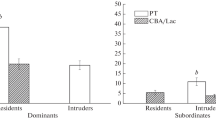Abstract
Responses to the odor of familiar intruder male mice according to their dominance were investigated. Responses were classified into 2 aspects: the investigation of the odor and the decision-making regarding avoiding it or not. The results varied according to the dominance of the respondents and the odor donor, and also according to the context of previous encounter situations. The dominants that had attacked an intruder dominant mouse responded randomly to its odor, whereas the dominants that had fought with it tended to avoid the odor. The subordinates that had observed an intruder dominant mouse being attacked by its dominant cagemate preferred the passage with the intruder's odor. The odor of a subordinate mouse was neither avoided nor preferred by either the dominants or subordinates. It was suggested that mice distinguished the dominance of the odor donor regardless of the context of the previous encounter situation, but they responded differently according to it and also according to their own dominance status.
Similar content being viewed by others
References
Barnard, C.J. & J. Fitzsimons 1988 Kin recognition and mate choice in mice: the effects of kinship, familiarity and social interference on intersexual interaction.Anim. Behav., 36: 1078–1090.
Bowers, J.M. & B.K. Alexander 1967 Mice: Individual recognition by olfactory cues.Science., 158: 1208–1210.
Brain, P.F., M.H. Homady & M. Mainardi 1983 Preputial glands, dominance and aggressiveness, in mice.Boll. Zool., 50: 173–187.
Bronson, F.H. 1973 Establishment of social rank among grouped male mice: relative effects on circulating FSH, LH, and corticosterone.Physiol. Behav., 10: 947–951.
Bronson, F.H. & H.M. Marsden 1973 The preputial gland as an indicator of social dominance in male mice.Behav. Biol., 9: 625–628.
Brown, R.E. 1985 The rodents II: suborder Myomopha. In: R.E. Brown & D.W. Macdonald (eds)Social odours in mammals. Volume 1. Clarendon Press, Oxford. pp. 345–457.
Carr, W.J., R.D. Martorano & L. Krames 1970 Responses of mice to odors associate with stress.J. Comp. Physio. Psychol., 71: 223–228.
Carr, W.J., P. Roth & M. Amore 1971 Responses of male mice to odors from stressed vs nonstressed males and femalesPsychon. Sci., 25: 275–276.
Connor, J.L. & P.G. Lynds 1977 Mouse aggression and the intruder-familiarity effect: evidence for multiple-factor determination.J. Comp. Physio. Pshychol., 91: 270–280.
Cox, T.P. 1984 Ethological isolation between local populations of house mice (Mus musculus) based on olfaction.Anim. Behav., 32: 1068–1077.
Gellermann, L.W. 1933 Chance orders of alternating stimuli in visual discrimination experiments.J. Genet. Psychol., 42: 206–208.
Hahn, M.E. Jr. & E.C. Simmel 1968 Individual recognition by natural concentrations of olfactory cues in mice.Psychon. Sci., 12: 183–184.
Harrington, J.E. 1976 Recognition of territorial boundaries by olfactory cues in mice (Mus musculus L.).Z. Tierpsychol., 41: 295–306.
Hurst, J.L. 1989 The complex network of olfactory communication in populations of wild house miceMus domesticus Rutty: urine marking and investigation within family group.Anim. Behav., 37: 705–725.
Hurst, J.L., J. Fang & C.J. Barnard 1993 The role of substrate odours in maintaining social tolerance between male house mice,Mus musculus domesticus.Anim. Behav., 45: 997–1006.
Jones, R.B. & N.W. Nowell 1973 Aversive and aggression-promoting properties of urine from dominant and subordinate male mice.Anim. learn. Behav., 1: 207–210.
Jones, R.B. & N.W. Nowell 1974 A comparison of the aversive and female attractant properties of urine from dominant and subordinate male mice.Anim. Learn. Behav., 2: 141–144.
Kaufmann, J.H. 1983 On the definitions and functions of dominance and territoriality.Biol. Rev., 58: 1–20.
Kimelman, B.R. & R.E. Lubow 1974 The inhibitory effect of preexposed olfactory cues on intermale aggression in mice.Physio. Behav., 12: 919–922.
Lenington, S., K. Egid & J. Willams 1988 Analysis of a genetic recognition system in wild house mice.Behav. Genet., 18: 549–564.
Machida, T., Y. Yonezawa & T. Noumura 1981 Age-associated changes in plasma testoster-one levels in male mice and their relation to social dominance or subordinance.Hormon. Behav., 15: 238–245.
Mackintosh, J.H. & E.C. Grant 1966 The effect of olfactory stimuli on the agonistic behaviour of laboratory mice.Z. Tierpsychol., 23: 584–587.
Rowe, F.P. & R. Redfern 1969 Aggressive behaviour in related and unrelated wild house mice (Mus musculus L.).Ann. appl. Biol 64: 425–431.
Schultz, E.F., J.T. Tapp 1973 Olfactory control of behavior in rodents.Psychol. Bull., 79: 21–44.
Selmanoff, M.K., B.D. Goldman & B.E. Ginsburg 1977 Serum testosterone, agonistic behavior, and dominance in inbred strains of mice.Hormon. Behav., 8: 107–119.
Winn, B.E. & B.M. Vestal 1986 Kin recognition and choice of males by wild female house mice (Mus musculus).J. Comp. Psychol., 100: 72–75.
Yamazaki, K., M. Yamaguchi, L. Baranoski, J. Bard, E.A. Boyse & L. Thomas 1979 Recognition among mice. Evidence from the use of a Y-maze. Differentially scented by congenic mice of different major histocompatibility types.J. Exp. Med., 150: 755–760.
Zielinski, W.J. & J.G. Vandenbergh 1993 Testosterone and competitive ability in male house mice,Mus musculus: laboratory and field studies.Anim. Behav., 45: 873–891.
Author information
Authors and Affiliations
About this article
Cite this article
Koyama, S. Differential response to the odor of familiar intruder mice in male mice (Mus musculus). J. Ethol. 13, 47–56 (1995). https://doi.org/10.1007/BF02352562
Received:
Accepted:
Issue Date:
DOI: https://doi.org/10.1007/BF02352562




